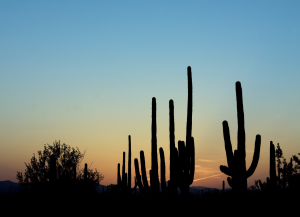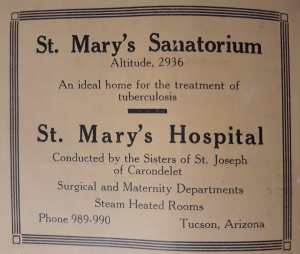The dry climate of the Southwest has long been an attraction for visitors, many of whom become residents. While physicians debated the effect of a dry climate on the health of tuberculosis sufferers, thousands of tuberculars moved to Tucson around the time of World War I. During the 1920s and 1930s the dry climate of Tucson continued to attract people suffering from the disease of tuberculosis.
Impoverished tuberculars, or “lungers” as they were disparagingly called, lived on several acres of desert north of the University of Arizona. The area pejoratively called Tent City, Tentville, or Lunger (Lung) Hill was located in what is now the Feldman neighborhood, bordered on the north by East Lee Street, the south by East Speedway, the east by North Park Avenue and the west by North Stone Avenue.
Because there was such a flood of tuberculosis sufferers, sanitariums (alternately sanatoriums) began to be built in Tucson to house and treat them. According to Tucson City Directories many such facilities were opened only to close in a short time.
Some, like the Barfield Sanatorium changed hands but stayed open for several decades. In 1952, the Barfield Sanatorium (Karl F. Barfield) at 2108 E. Speedway became the Oshrin Hospital under Albert S. Oshrin. The hospital treated Diné (Navajo) and Hopi tuberculosis sufferers.
There are several surviving structures that were sanitariums that are currently used for other purposes: St. Luke's in the Desert, Whitwell Hospital and Sanatorium, Desert Sanatorium, St. Mary’s Hospital and Sanatorium, and the Veterans Affairs Medical Center.
St. Luke’s
St. Luke's in the Desert (615 E. Adams Street) began in 1917 as a small sanitarium run by the Episcopal Church. Located in what is today the Feldman neighborhood, St. Luke's in the Desert was used as a tuberculosis sanitarium until 1968. After 1968, St. Luke’s continued to treat respiratory diseases until it closed in 1972. In 1980, St. Luke’s was reopened as an assisted-living facility for women. In 2000, St. Luke’s became a facility for men and women.
Whitwell
Established in 1906, initially the private 30-bed Whitwell Hospital under physician Hobart P. Shattuck (721 East Adams) did not admit tuberculosis patients. However from from 1912-1925 Whitwell functioned as a tuberculosis sanitarium. The Whitwell then became the Southern Methodist hospital from 1927-1938. Currently the Whitwell is the Castle apartments and brief history of the Castle Apartments lists other uses for this unique structure.
Desert Sanatorium
The Desert Sanatorium of Southern Arizona opened on Beverly Boulevard on November 15, 1926. This 120-bed sanitarium was the first in the United States to treat, and attempt to cure, tuberculosis by direct solar radiation (sunlight.) Operating as a private facility, the Desert Sanatorium attracted wealthy patients. On March 2, 1944 the Desert Sanatorium was deeded to Tucson Medical Center.
St. Mary’s Hospital and Sanatorium
Originally having come to Tucson to establish schools in 1870, nuns of the Sisters of St. Joseph of Carondelet spearheaded the building of a much needed hospital to serve the region. Opened in 1880, St. Mary’s Hospital continued to expand under the leadership of Superintendent Sister Fidelia McMahon and added the sanatorium known as the Isolation Cottage in 1900.
Veterans Affairs Medical Center
There were many tubercular veterans after World War I who sought treatment in Tucson, so in 1928 the Veterans Affairs Medical Center was built. The Veterans Affairs Medical Center, located at 3601 S. Sixth Avenue is still used as a hospital.
There were many other sanatoriums established in Tucson beginning in the late nineteenth century.
Sources:
Tucson City Directories, 1921-1928
“Sanatorium.” The Merriam-Webster.com Dictionary, Merriam-Webster Inc.
Tucson Health Seekers: Design, Planning, and Architecture in Tucson for the Treatment of Tuberculosis. Tucson Historic Preservation Foundation
Lapp, A D. “Treating Tuberculosis in the Dry Climate Belt.” Canadian Medical Association journal vol. 15, 8 (1925): 819-22.
Feldman's Edition, Newsletter of the Feldman's Neighborhood Association. December 2006. Page 1.
American Medical Association. American Medical Directory, Volume 2, 1909, Page 70
“New sidewalks make walking a pleasure.” Arizona Daily Star. May 21, 2008. Page D1.
Rogers, W. Lane. “Sanitarium of the Southwest Seeking a Cure in the Arizona Sunshine." Desert Leaf. January 1992.
Henry, Bonnie. “St. Luke’s: 9 decades of solace for the sick, the aged.” Arizona Daily Star. November 16, 2005. Page. B1
Henry, Bonnie. “Tuberculosis, arthritis drove many sufferers to Tucson.” Arizona Daily Star. May 24, 1997. Page D1.
Devine, David. Tucson: A History of the Old Pueblo from the 1854 Gadsden Purchase. United States, McFarland, Incorporated, Publishers, 2015.
Find the information you need by calling the library's Infoline at 520-791-4010 or by sending your question to Ask a Librarian.



